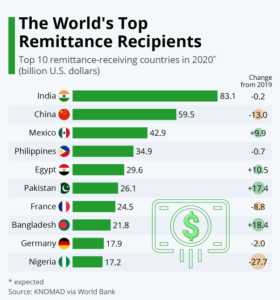
At the 13th Ministerial Conference of the World Trade Organisation in Abu Dhabi, India’s proposal to reduce cross-border remittance charges received overwhelming support, except from the US. This proposal aligns with the UN Sustainable Development Goal 10.c which seeks to keep remittance transaction costs below 3% and eliminate corridors exceeding 5% by 2030. According to the World Bank, over 75% of remittances go to developing countries, where transfer costs can reach as high as 10-15% for smaller transactions.
The dominance of the dollar in international payment settlements means that the costs of such fund transfers usually rest with US banks, making the US the sole notable exception to resist India’s proposal. As the largest recipient of remittances globally, India is significantly impacted. Developing countries like India need to find ways to reduce remittance costs.
READ | Infrastructure investment: Need to mitigate risks for private sector
Leveraging UPI
Unified Payments Interface presents both opportunities and challenges for reducing cross-border remittance costs. Its efficient architecture and streamlined processes enable lower transaction costs compared with legacy remittance channels, translating to savings for remitters, typically Indian workers and expatriates. Moreover, Unified Payments Interface offers faster settlement of funds, resulting in quicker remittance delivery and eliminating delays associated with traditional methods.
Unified Payments Interface’s digital system can increase transparency and encourage the shift of remittances from informal channels to official, regulated ones, benefiting India’s overall economy. Additionally, Unified Payments Interface’s entry into the cross-border remittance space fosters competition among providers, pushing them to offer more cost-effective and efficient services.

However, integrating Unified Payments Interface into cross-border remittance systems faces challenges due to varying regulatory environments across countries. Each nation’s financial laws and data storage requirements add complexity, hindering seamless Unified Payments Interface integration and increasing compliance costs. Strict adherence to KYC and AML regulations further complicates the process. System integration poses another hurdle, particularly concerning interoperability and scalability with diverse banking systems and payment gateways. Currency exchange rates remain a critical issue, especially considering the non-convertibility of the Indian Rupee.
Ensuring real-time, transparent, and cost-effective currency exchange mechanisms within cross-border UPI transfers is paramount, necessitating the creation of mechanisms with prospective money-changers globally, including developing fintech applications. Robust cybersecurity measures, risk assessment protocols, and fraud prevention strategies aimed at ensuring financial security are also essential. Additionally, Unified Payments Interface faces resistance from traditional remittance providers and corridors, potentially slowing its adoption, along with limited partner networks and challenges in user awareness and adoption. Overcoming these hurdles requires concerted efforts and innovative solutions to realise the full potential of Unified Payments Interface in cross-border remittances.
Anchoring CBDCs for remittance
The Reserve Bank of India (RBI) has introduced CBDC domestically but has received a subdued response and is also actively exploring the option of a digital payment system for cross-border settlements. A digital BRICS currency is also an option. However, to fully realise the benefits, India would need to collaborate with other countries to create common standards and establish regulatory frameworks.
CBDC has the potential to significantly reduce remittance costs and transform the international payment ecosystem. CBDCs can facilitate direct transfers between the central banks of different countries, potentially bypassing the correspondent banking network, particularly the US. This reduces intermediaries, lowers transaction fees, and increases speed. Additionally, CBDCs operate on distributed ledger technology (DLT), offering increased transparency and traceability of transactions, which enhances efficiency, reduces the potential for errors, and aids regulatory compliance. Besides, CBDCs can stimulate competition in the remittance market, potentially leading to the development of new, more cost-effective services by other central banks, monetary unions, and private sector players, thus fostering fintech innovations.
More importantly, CBDCs may give central banks greater control over monetary policy, as they can potentially track cross-border flows of currency with more precision. However, the concept is new, with a low response from users even domestically, and the beneficiaries of the existing system have consistently thwarted calls for a digital currency, as seen at the recent G-20 Summit. The digital infrastructure requirements for technical standardisation and interoperability between different countries’ systems, along with regulatory uncertainties across different jurisdictions, should not be underestimated. Moreover, if a foreign CBDC becomes widely adopted in India, it could lead to currency substitution, where people prefer the foreign CBDC over the Rupee, presenting risks to monetary policy and financial stability.
Like Unified Payments Interface, CBDC systems would also need robust cybersecurity measures to protect against hacking, fraud, and data breaches, which could undermine user trust. The benefits of CBDCs for cross-border remittances hinge upon the widespread adoption of CBDCs by multiple countries. Until significant adoption is achieved, traditional methods will remain necessary. Ensuring widespread adoption of CBDCs among the Indian population would require significant public education and awareness campaigns.
Way Forward
A hybrid approach integrating Unified Payments Interface and CBDCs offers India an optimal solution to significantly reduce cross-border remittance costs. Unified Payments Interface’s efficiency in domestic payments and global partnerships facilitates seamless “last mile” distribution, ensuring quick and affordable receipt of remittances. Simultaneously, CBDCs have the potential to streamline wholesale settlements, eliminating intermediaries and reducing transaction costs upfront. This hybrid model allows for the development of robust currency exchange solutions, further minimising costs associated with cross-border remittances.
By expanding the Unified Payments Interface network globally and exploring a digital currency system, India can leverage the strengths of both technologies to create an efficient and cost-effective transfer corridor. Success in this endeavour not only promotes financial inclusion but also sets a precedent for similar digital infrastructure in other developing countries, particularly those of the Global South, which supported India’s initiative at the WTO to reduce remittance costs.
(Dr Ram Singh is professor, and Aaqib Chaudhary a research scholar at IIFT, New Delhi.)
